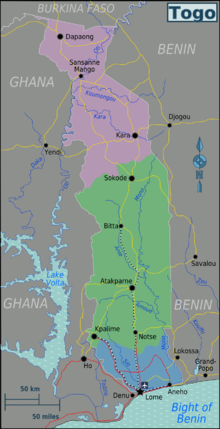Affair of Khra
The invaders paused for two days and resumed the advance on Kamina; they were met at Glei, on 25 August, by two Germans who offered terms of surrender.
An Offensive Sub-Committee of the Committee of Imperial Defence which had been appointed on 5 August established a principle that command of the seas was to be ensured.
[2] Objectives at Tsingtau in the Far East and Luderitz Bay (Angra Pequena), Windhoek, Duala and Dar es Salaam in Africa, were considered feasible and a German wireless station in Togoland, next to the British colony of Gold Coast (now Ghana) in the Gulf of Guinea, was judged to be within the capacity of local forces.
The Germans left for Kamina and surrendered Togoland up to the Khra River, 75 mi (120 km) inland, to prevent a naval bombardment of Lomé.
[6] By 12 August, the Togo coast and Lomé had been occupied, with little resistance from the Germans who had withdrawn to Kamina, 100 mi (160 km) inland, on hills near Atakpamé.
A wireless station had been built at the village for communication between Germany and its African colonies, South America and German shipping in the Atlantic.
The Anglo-French advance towards Kamina was slowed by German demolitions of railway bridges, which made movement difficult and delayed the transport of supplies.
Captain Georg Pfähler, the German military commander, travelled south on two trains with 200 soldiers, towards the main Entente columns.
[8] On 4 and 5 August, in the north of the Gold Coast colony, two twenty-man detachments of Northern Territories Constabulary, advanced from Tamale to Zan on the frontier.
Due to a misunderstanding, orders from Bryant for a company of the Gold Coast Regiment already in Zan, to occupy Krachi had also been obeyed by the Constabulary.
Bryant ordered the detachments at Lomé and Ho to move to Palime to guard the flank of the main force, advancing from the south.
Two Preventive Service officers used a motor cycle to drive about 30 mi (48 km) from Lomé and cut the Lomé–Palime railway line.
In the north of Togoland, British and French troops, police and volunteers invaded and reached Yendi and Sansane Mangu by 14 August.
[11] More detachments followed, c. 200 Togolese troops in the area deserted, many of the rest retreated and the local civilian authorities hurried to repudiate German allegiance.
[13] The Affair of Agbeluvoe was considered a great defeat of the Germans by local civilians but it delayed briefly the British advance to the north, until 19 August.
The Germans were not able to obtain information about the British in the neighbouring colony of Gold Coast (now Ghana) and instructions by wireless from Berlin, merely insisted that the transmitting station be protected.
The order to retire was given overnight and was unwelcome, because the defenders believed that they could delay the Allies for much longer, given the strength of the position and casualties of only thirteen men.
During the night Bryant prepared to resume the attack at dawn, by ordering the troops on the right to dig in and by reinforcing I Company on the left flank.
[23] The German intelligence system had broken down when the war began and no news had been brought from the Gold Coast, due to lack of co-operation from Togolese civilians.
The speed of the Allied invasion, the German overestimation of the numbers involved and the hostility of local civilians, proved to be insuperable obstacles.
The main force stayed at Khra from 23 to 24 August to bring up supplies and to return the wounded to Lomé, once the railway had been repaired and an ambulance train had been improvised by civilian officials.
[27] The pause of the Allied advance at Khra had given the Germans time to relay more messages between Germany and the colonies and then Von Doering had ordered that the wireless station be destroyed, before surrendering his 200 remaining troops, three machine-guns, more than 1,000 rifles and c. 320,000 rounds of ammunition.
[28] The Krachi Column advanced through Ahenkro and Liati to reach Palime on 23 August and was joined by a civilian, Mr. Beckley with messages from Bryant.

